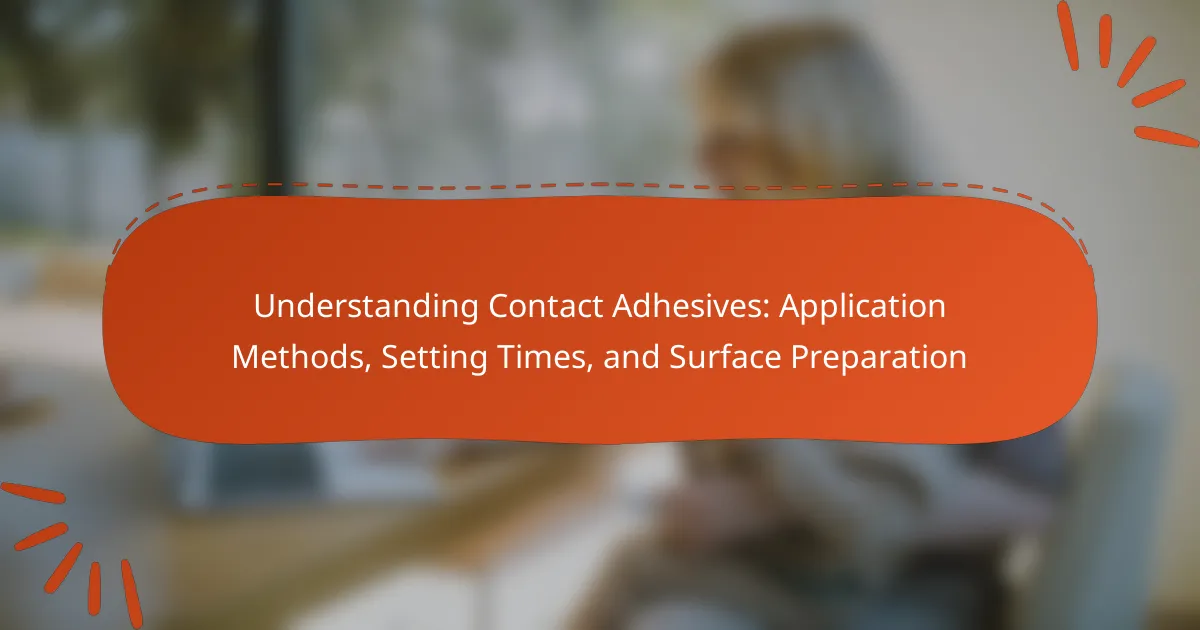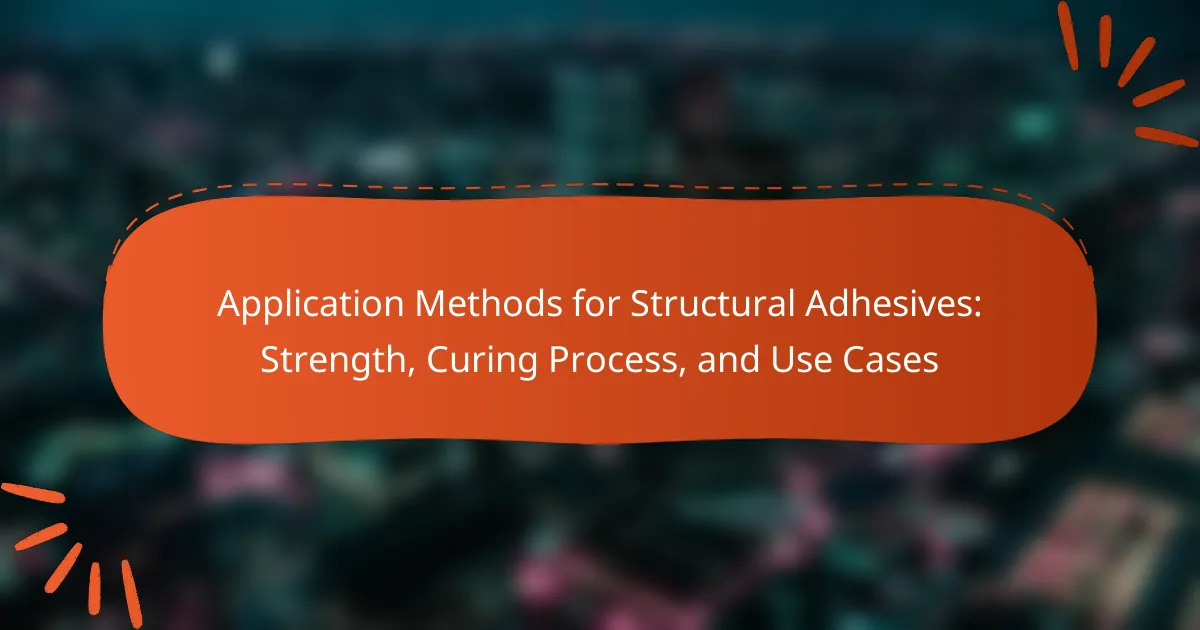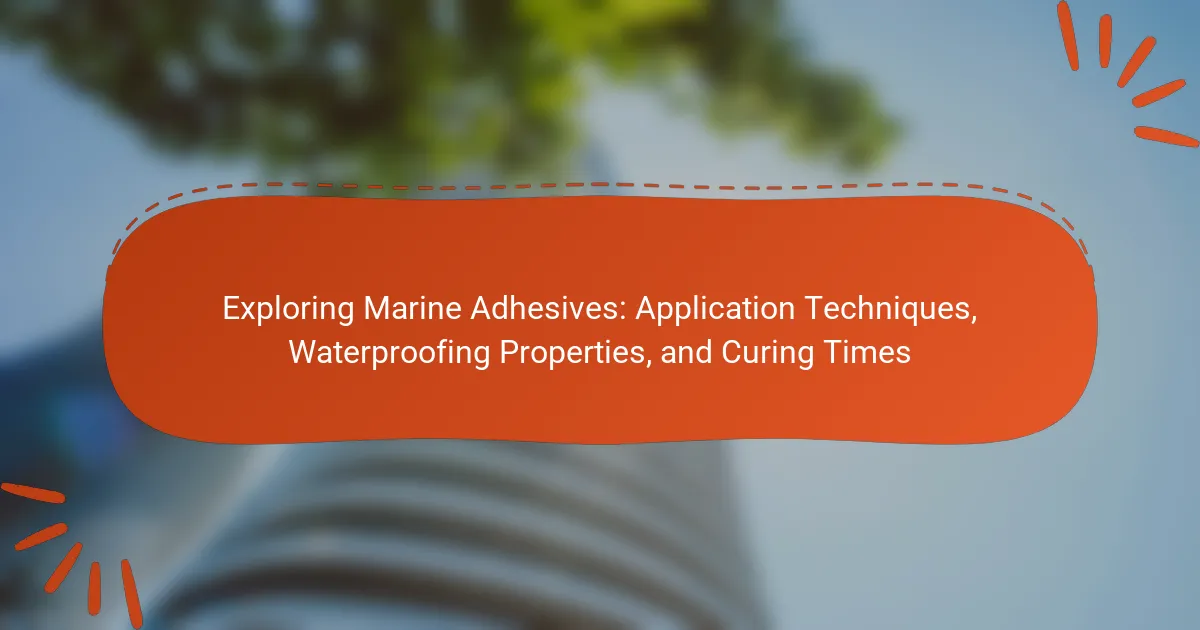Contact adhesives are a type of adhesive that bond materials instantly upon contact, typically available in solvent-based or water-based formulations. This article explores the application methods for contact adhesives, emphasizing the importance of surface preparation, which includes ensuring surfaces are clean, dry, and free of contaminants. It details the setting times associated with these adhesives, which can vary based on temperature and humidity, and provides guidance on achieving optimal bonding strength. Key application techniques, including the use of brushes, rollers, or spray methods, are also discussed, along with tips for enhancing adhesion through surface roughening.
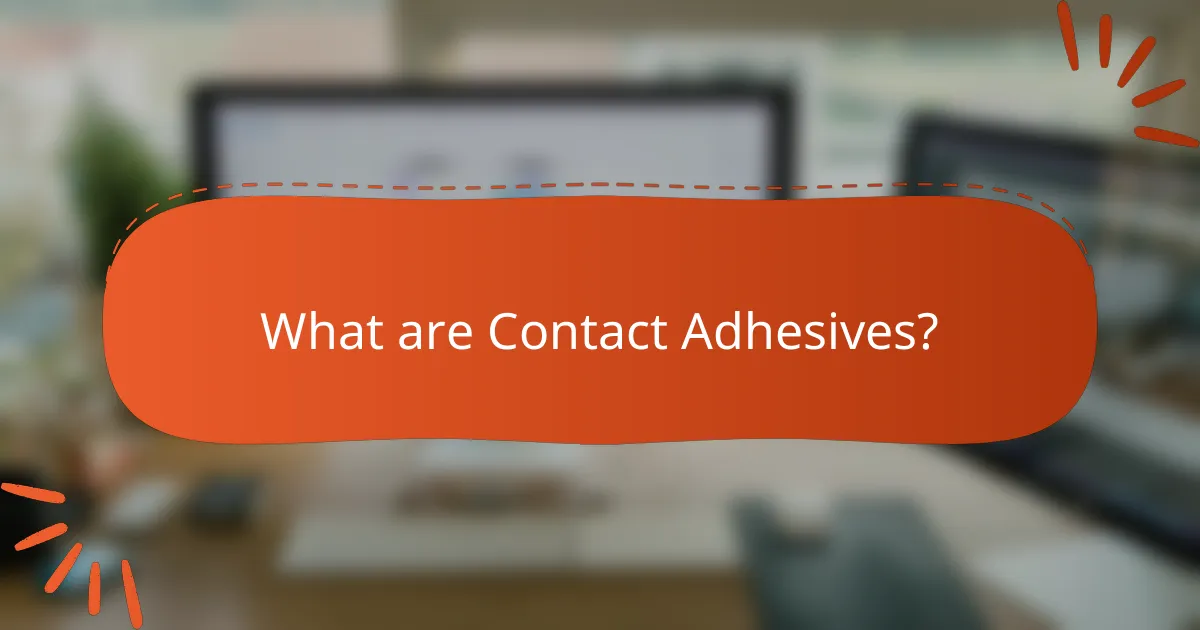
What are Contact Adhesives?
Contact adhesives are a type of adhesive that bond materials upon contact. They are typically solvent-based or water-based formulations. These adhesives create an instant bond when two coated surfaces are pressed together. They are commonly used in applications requiring strong, flexible bonds. Contact adhesives are ideal for bonding laminates, veneers, and various substrates. Their quick setting time allows for immediate handling after application. This type of adhesive is popular in woodworking and construction industries. The effectiveness of contact adhesives is due to their ability to adhere to a wide range of materials.
How do Contact Adhesives differ from other adhesives?
Contact adhesives differ from other adhesives primarily in their application and bonding process. They require both surfaces to be coated and allowed to dry before being pressed together. This creates an immediate bond upon contact, unlike many adhesives that require curing time. The bonding strength of contact adhesives is often higher for non-porous materials. They are particularly effective on surfaces like metal, plastic, and laminate. In contrast, other adhesives may not bond as quickly or effectively on these surfaces. Contact adhesives also remain flexible after curing, which can be beneficial in applications subject to movement.
What are the chemical compositions of Contact Adhesives?
Contact adhesives are primarily composed of elastomers, resins, solvents, and additives. Common elastomers include polychloroprene and polyvinyl acetate. Resins often consist of phenolic or epoxy compounds that enhance bonding strength. Solvents help dissolve the adhesive components for application and can include toluene or acetone. Additives may include stabilizers and fillers to improve performance. The specific chemical composition can vary by manufacturer and formulation, impacting adhesion properties and application methods.
What types of surfaces can Contact Adhesives bond?
Contact adhesives can bond a variety of surfaces, including wood, metal, plastic, and rubber. They are effective on porous and non-porous materials. Contact adhesives provide a strong bond when applied to both smooth and rough surfaces. This versatility makes them suitable for construction and manufacturing applications. The bonding strength is achieved through the adhesive’s formulation, which allows it to penetrate surface textures. Additionally, they can be used on laminate and fiberglass materials. Their ability to bond dissimilar materials is a significant advantage in many projects.
What are the key attributes of Contact Adhesives?
Contact adhesives are characterized by their ability to bond surfaces upon contact. They provide strong adhesion for various materials, including wood, metal, and plastic. These adhesives typically require no clamping and offer quick setting times. They are resistant to heat and moisture, enhancing durability. Contact adhesives also feature a flexible bond that accommodates movement between surfaces. Additionally, they can be applied in multiple forms, such as liquid or spray. Their versatility makes them suitable for both industrial and household applications.
What are the benefits of using Contact Adhesives?
Contact adhesives provide strong, immediate bonding for various materials. They are versatile and can bond wood, metal, plastic, and fabric. Contact adhesives allow for repositioning before full adhesion occurs. They offer resistance to heat, water, and chemicals, enhancing durability. The application is straightforward, requiring no special tools. They also dry quickly, facilitating faster project completion. Their flexibility allows for movement without breaking the bond. Many contact adhesives are available in spray or liquid form, catering to different preferences.
What factors affect the performance of Contact Adhesives?
The performance of contact adhesives is affected by several key factors. These include surface preparation, which ensures proper adhesion by removing contaminants. The type of substrates being bonded also plays a critical role. Different materials may require specific adhesive formulations for optimal performance. Environmental conditions, such as temperature and humidity, can influence curing times and bond strength. The application method affects the uniformity of adhesive spread, impacting overall performance. Additionally, the adhesive’s chemical composition determines its suitability for various applications. Proper curing time is essential for achieving maximum bond strength. Each of these factors must be carefully managed to ensure effective use of contact adhesives.
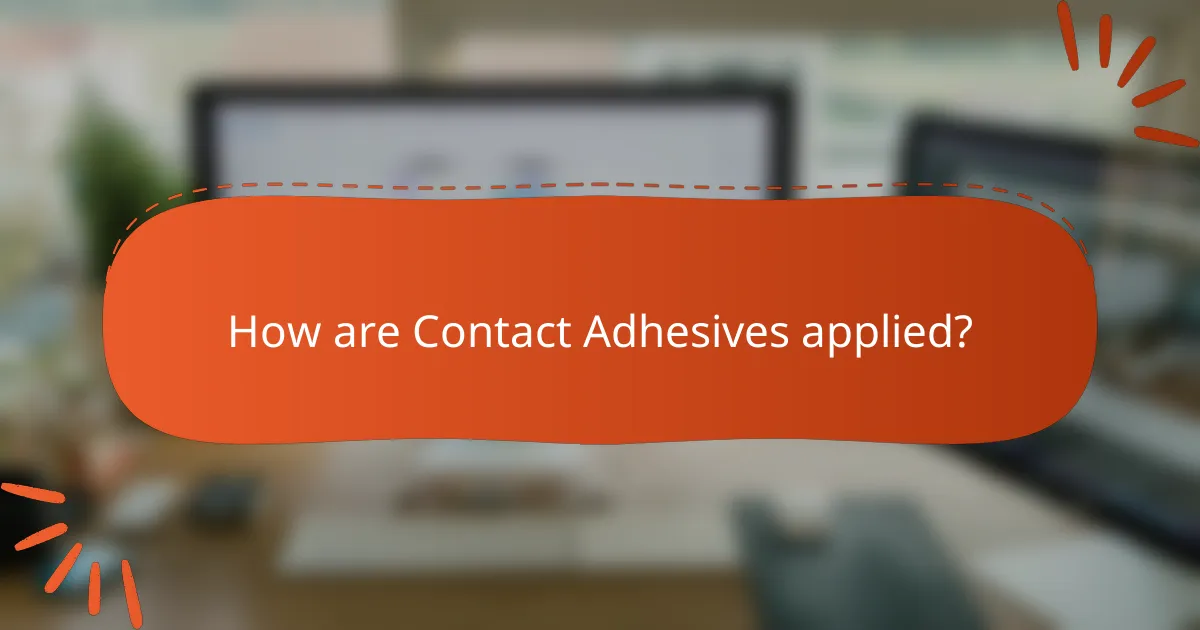
How are Contact Adhesives applied?
Contact adhesives are applied by using a brush, roller, or spray method. First, surfaces must be clean and dry before application. The adhesive is evenly coated on both surfaces to be bonded. After application, allow the adhesive to dry until it becomes tacky. Once tacky, the surfaces are pressed together firmly. This creates an instant bond upon contact. Proper pressure ensures a strong adhesion. Following these steps guarantees effective bonding with contact adhesives.
What are the different application methods for Contact Adhesives?
Contact adhesives can be applied using several methods. The primary application methods include brush application, roller application, spray application, and trowel application.
Brush application involves using a brush to evenly spread the adhesive on the surfaces. This method is suitable for small areas or intricate designs. Roller application employs a roller to cover larger surfaces quickly. It ensures even distribution of adhesive.
Spray application utilizes a spray gun for even and fine coverage. This method is efficient for large-scale projects. Trowel application involves using a trowel to spread adhesive, often for thicker layers. Each method allows for effective bonding based on the project requirements.
How does brush application compare to spray application?
Brush application allows for greater control and precision compared to spray application. It is ideal for smaller, detailed projects where accuracy is crucial. Brush application also minimizes overspray, reducing waste of adhesive. In contrast, spray application covers larger areas more quickly. It is effective for even and uniform distribution over surfaces. However, spray application may lead to overspray and requires protective measures for surrounding areas. Studies show that brush application can result in thicker layers, enhancing bond strength in specific applications. Spray application, on the other hand, is often preferred for speed and efficiency in larger tasks.
What are the best practices for roller application?
The best practices for roller application include using a high-quality roller suited for the adhesive type. Select a roller with the appropriate nap length for even coverage. Ensure the surface is clean and dry before application. Apply the adhesive evenly in one direction to avoid bubbles. Maintain a consistent speed to ensure a uniform layer. Allow the adhesive to set according to the manufacturer’s instructions. Clean the roller immediately after use to maintain its effectiveness. Proper storage of the adhesive can also enhance performance during future applications.
What precautions should be taken during application?
During the application of contact adhesives, several precautions should be taken. Ensure the workspace is well-ventilated to avoid inhaling fumes. Wear appropriate personal protective equipment, such as gloves and goggles, to protect skin and eyes. Follow the manufacturer’s instructions regarding application thickness and drying times. Avoid applying adhesives near open flames or sources of ignition due to flammability. Test the adhesive on a small area first to check compatibility with surfaces. Store adhesives in a cool, dry place to maintain their effectiveness. Properly dispose of any unused adhesive according to local regulations to prevent environmental harm. These precautions enhance safety and ensure optimal bonding performance.
What safety gear is recommended when using Contact Adhesives?
When using contact adhesives, it is recommended to wear safety goggles, gloves, and a respirator. Safety goggles protect the eyes from chemical splashes. Gloves prevent skin contact with harmful substances. A respirator filters out harmful vapors and dust. These safety gear items help minimize health risks associated with exposure. The use of personal protective equipment (PPE) is essential when handling volatile organic compounds (VOCs) found in many contact adhesives. According to the Occupational Safety and Health Administration (OSHA), proper PPE reduces the risk of respiratory issues and skin irritation.
How can one ensure proper ventilation during application?
Ensure proper ventilation by working in a well-ventilated area. Open windows and doors to increase airflow. Use fans to circulate air if necessary. Avoid applying adhesives in enclosed spaces. Wear a mask to protect against fumes. Follow the manufacturer’s safety guidelines regarding ventilation. Proper ventilation reduces the risk of inhaling harmful vapors. Studies show that adequate ventilation significantly lowers exposure to toxic substances during adhesive application.
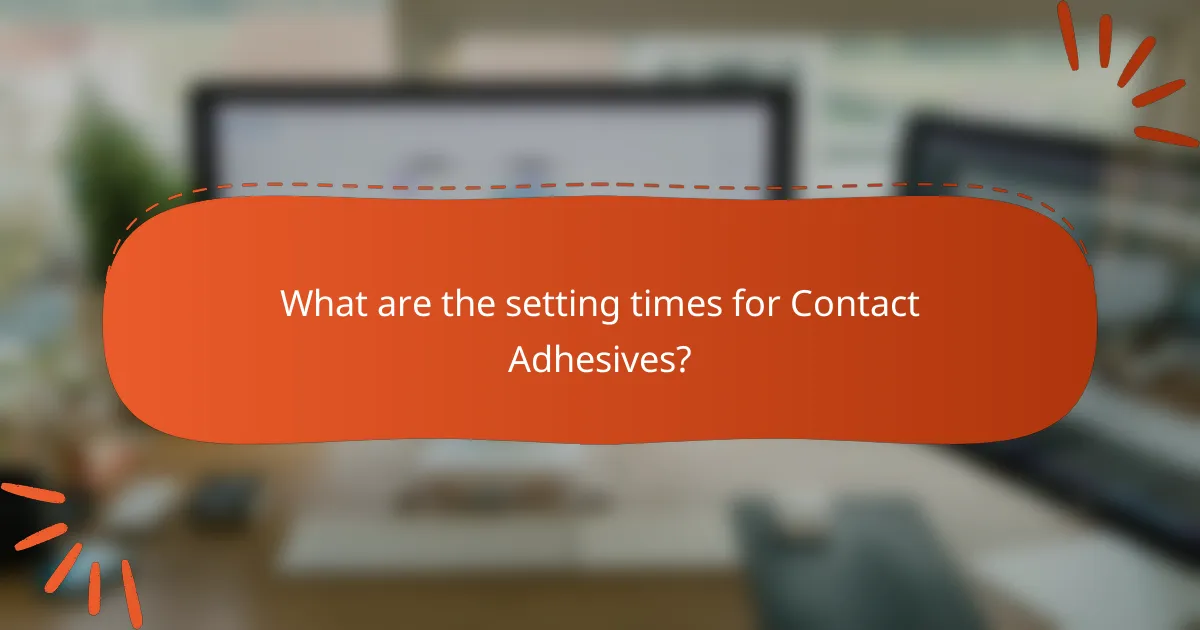
What are the setting times for Contact Adhesives?
Setting times for contact adhesives typically range from 15 minutes to several hours. The initial tack often develops within 10 to 30 minutes. Full bond strength may take 24 hours to achieve. Factors such as temperature and humidity can influence these times. Higher temperatures generally speed up the setting process. Conversely, lower temperatures can prolong it. Specific product instructions should always be followed for optimal results.
How do setting times vary among different types of Contact Adhesives?
Setting times vary significantly among different types of contact adhesives. Solvent-based contact adhesives typically have longer setting times, ranging from 15 to 30 minutes. Water-based contact adhesives usually set faster, often within 10 to 20 minutes. Hot melt adhesives can set almost instantly upon cooling, sometimes within seconds. The specific formulation and intended use of each adhesive type influence these times. For example, high-performance adhesives may require longer curing times to achieve maximum bond strength. Conversely, quick-drying adhesives are designed for rapid applications. These variations are essential for selecting the appropriate adhesive for specific projects.
What factors influence the setting time of Contact Adhesives?
The setting time of contact adhesives is influenced by several factors. Temperature plays a significant role; higher temperatures generally speed up the setting process. Humidity levels also affect setting time; increased humidity can slow down the curing. The type of adhesive used is crucial; different formulations have varying setting times. Surface preparation impacts adhesion and can either expedite or delay setting. The thickness of the adhesive layer is another factor; thicker layers typically take longer to set. Lastly, the presence of solvents in the adhesive can alter the evaporation rate, influencing the overall setting time.
How can users determine the right setting time for their projects?
Users can determine the right setting time for their projects by consulting the adhesive manufacturer’s specifications. These specifications typically provide recommended setting times based on environmental conditions and material types. Factors such as temperature and humidity can significantly influence setting times. For example, higher temperatures may accelerate curing while higher humidity can slow it down. Testing a small area before full application can help gauge the adhesive’s performance under specific conditions. Additionally, users should consider the type of materials being bonded, as different substrates may require different setting times. Monitoring the adhesive’s tackiness can also indicate readiness for further handling or bonding.
What are the signs that a Contact Adhesive has set properly?
The signs that a contact adhesive has set properly include a firm bond and no tackiness on the surface. The adhesive should feel dry to the touch. It is essential that both surfaces are securely adhered together. A proper set is indicated when the materials cannot be easily separated. Additionally, the bond strength increases over time as the adhesive cures. Testing the bond by applying slight pressure should show no movement. If the adhesive is transparent and has a consistent finish, it is likely set correctly. These indicators ensure the adhesive has reached its optimal performance.
What should users look for to confirm adhesion success?
Users should look for a strong bond and no visible gaps to confirm adhesion success. The surface should feel secure and not separate under gentle pressure. Users can check for uniform coverage of adhesive across the bonded area. Additionally, a successful bond will resist peeling or lifting at the edges. The materials should remain aligned without shifting. Testing the bond after the recommended setting time is essential. If the adhesive cures as specified, it indicates a successful adhesion.
How can one troubleshoot issues related to setting times?
To troubleshoot issues related to setting times of contact adhesives, first check the manufacturer’s instructions. Ensure that the adhesive is applied within the recommended temperature range. Verify that the surfaces are clean and free of contaminants. Inspect the thickness of the adhesive layer; too much or too little can affect curing time. Ensure proper ventilation in the application area, as inadequate airflow can slow down drying. If the adhesive has expired, it may not set correctly. Lastly, consider the humidity levels; high humidity can prolong setting times. These steps will help identify and resolve common issues with setting times.
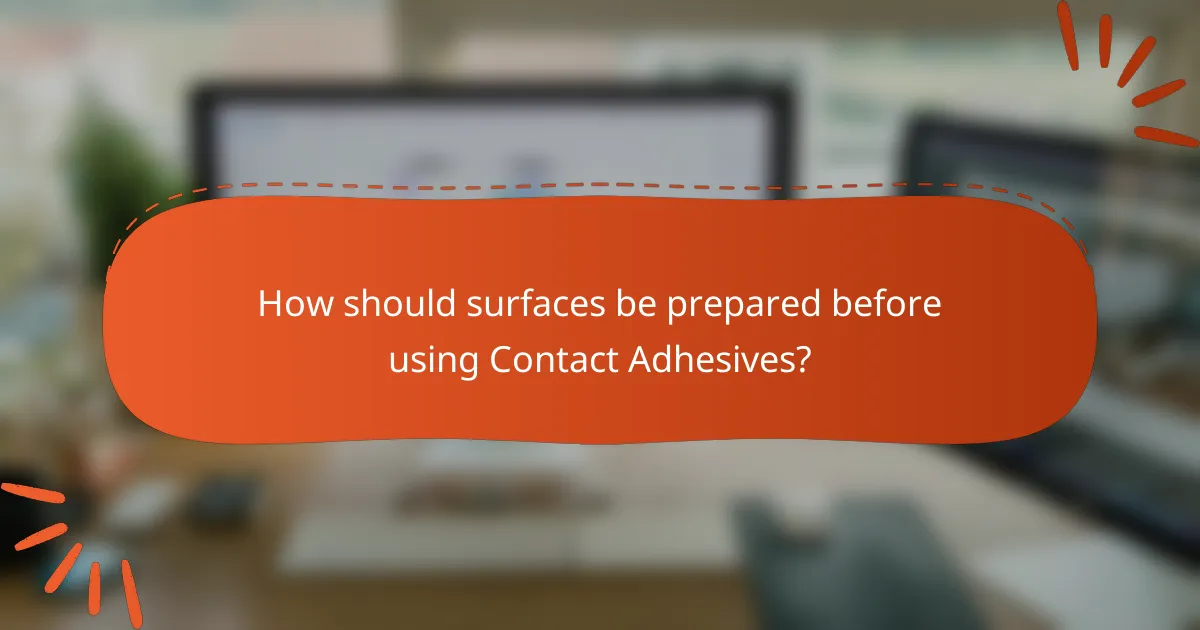
How should surfaces be prepared before using Contact Adhesives?
Surfaces should be clean, dry, and free of contaminants before using contact adhesives. Cleaning removes dust, grease, and moisture that can interfere with adhesion. Use a suitable solvent or cleaner for the specific surface material. Ensure the surface is dry to prevent adhesive failure. Roughening the surface can enhance bonding by increasing the surface area. Sanding or using a primer may be necessary for certain materials. Following these steps ensures optimal adhesive performance and durability.
What are the essential steps for surface preparation?
The essential steps for surface preparation include cleaning, sanding, and priming the surface. Cleaning removes dirt, grease, and contaminants. This ensures proper adhesion of the contact adhesive. Sanding creates a rough texture, enhancing the bond. It also removes any existing coatings that may interfere. Priming is sometimes necessary for porous surfaces. This step helps to seal the surface and improve adhesion. Each of these steps is crucial for achieving optimal results with contact adhesives. Proper surface preparation can significantly increase the longevity and effectiveness of the adhesive bond.
Why is cleaning the surface critical before application?
Cleaning the surface is critical before application because it ensures proper adhesion. Contaminants like dust, grease, and moisture can interfere with the bonding process. A clean surface allows the adhesive to make direct contact with the material. This enhances the strength and durability of the bond. Studies show that unclean surfaces lead to a 50% reduction in adhesive performance. Therefore, thorough cleaning is essential for optimal results.
How does surface texture affect adhesion?
Surface texture significantly affects adhesion by influencing the contact area between surfaces. Rough surfaces increase the mechanical interlocking, enhancing adhesion. Smooth surfaces may reduce interlocking, leading to weaker bonds. The presence of microscopic features on a textured surface can trap adhesive materials, further improving adhesion. Studies show that adhesives bond more effectively to surfaces with higher roughness values. For instance, a study published in the Journal of Adhesion Science and Technology found that increasing surface roughness led to a proportional increase in adhesive strength. Thus, optimizing surface texture is crucial for achieving stronger adhesive bonds.
What common mistakes should be avoided during surface preparation?
Common mistakes to avoid during surface preparation include inadequate cleaning, improper sanding, and neglecting moisture issues. Inadequate cleaning can leave contaminants on the surface, affecting adhesion. Improper sanding may create uneven surfaces, leading to poor bonding. Neglecting moisture issues can result in adhesive failure, as excess moisture can weaken the bond. Additionally, failing to follow manufacturer guidelines can lead to incorrect application. Each of these mistakes can compromise the effectiveness of contact adhesives. Proper surface preparation is crucial for achieving optimal results.
How can improper preparation impact the effectiveness of Contact Adhesives?
Improper preparation can significantly reduce the effectiveness of contact adhesives. Insufficient surface cleaning may leave contaminants that prevent proper bonding. For instance, oils, dust, or moisture can create a barrier between surfaces. This barrier weakens the adhesive’s grip and leads to premature failure. Additionally, uneven surface textures can hinder contact area, affecting adhesion strength. A study published in the Journal of Adhesion Science and Technology shows that proper surface preparation increases bond strength by up to 50%. Thus, neglecting preparation steps compromises the overall performance of contact adhesives.
What are the best practices for ensuring optimal surface conditions?
Ensuring optimal surface conditions involves thorough cleaning, proper surface profiling, and environmental control. Cleaning removes contaminants such as dust, grease, and moisture. Use appropriate solvents or detergents based on the surface material. Profiling enhances adhesion by creating a texture for the adhesive to grip. Sanding or using a blast media can achieve this. Environmental control maintains stable temperature and humidity levels. Ideal conditions are typically between 65°F to 85°F and 40% to 60% relative humidity. These practices enhance adhesive performance, ensuring a strong bond.
What are some practical tips for successful use of Contact Adhesives?
To successfully use contact adhesives, ensure proper surface preparation. Clean surfaces thoroughly to remove dust, grease, and moisture. Apply adhesive evenly on both surfaces for optimal bonding. Allow the adhesive to become tacky before joining the surfaces. Press the surfaces together firmly to ensure a strong bond. Maintain consistent pressure for the recommended setting time. Use appropriate ventilation to avoid inhaling fumes. Store adhesives in a cool, dry place to extend shelf life. Following these tips enhances adhesion quality and durability.
Contact adhesives are versatile bonding agents that create immediate adhesion upon contact, suitable for various materials including wood, metal, and plastic. This article explores the application methods, including brush, roller, and spray techniques, as well as setting times that typically range from 15 minutes to several hours, influenced by environmental conditions. It highlights the importance of proper surface preparation to ensure optimal bonding performance, detailing steps such as cleaning, sanding, and priming. Additionally, the article addresses precautions for safe application and troubleshooting common issues related to setting times and adhesion success.
